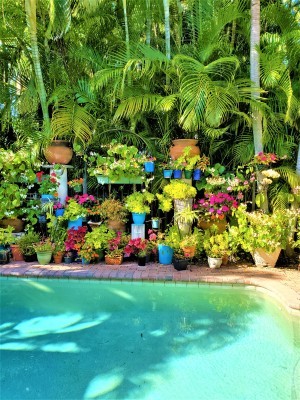 At the beginning of the season I select one plant of each type at a nearby nursery. When I get home I cut off each stem of the plant about an inch from the bottom. Then I cut all but the top 2 leaves off of each stem and place the stems in various sized jars of water to root. It generally takes a week or two for the roots to grow long enough to plant them in pots. By this time the original plants I purchased now have grown up once again and are blooming. I repeat this process as I need more plants. I save the seeds from most of my plants and dry them out to plant again and at the end of the season I dry and save them for next year.
At the beginning of the season I select one plant of each type at a nearby nursery. When I get home I cut off each stem of the plant about an inch from the bottom. Then I cut all but the top 2 leaves off of each stem and place the stems in various sized jars of water to root. It generally takes a week or two for the roots to grow long enough to plant them in pots. By this time the original plants I purchased now have grown up once again and are blooming. I repeat this process as I need more plants. I save the seeds from most of my plants and dry them out to plant again and at the end of the season I dry and save them for next year.
Because I have no land to plant in I am doing a vertical garden in pots. At garage sales I have accumulated many inexpensive plant stands of different heights. I also save the used filters from my pool to use as plant stands. I think of my garden as a beautiful painting. Here is a photo of what I have accomplished. Each year it changes as I find different flowers to add.
Share on ThriftyFunThis page contains the following solutions. Have something to add? Please share your solution!
I was inspired by the beautiful succulent decor walls at my local malls and stores. I wanted my own mini version in my backyard.
Ask a QuestionHere are the questions asked by community members. Read on to see the answers provided by the ThriftyFun community or ask a new question.
Has anyone ever tried "vertical gardening"? I am very excited to try this. I have a small balcony and love gardening and this sounds like the answer to my problem.
By Tammy from Parry Sound, ON

Vertical gardening is exactly what it sounds like: gardening vertically rather than horizontally, as we normally do.
It's ideal for those with limited space who garden in a small yard or on a terrace, deck or patio, but it also can be used effectively by any gardener who is interested in experiencing different types of gardening.
You can use fences, walls, trellises, arbors, pergolas and many different types of containers to garden vertically. As you add lush, draping plants, you can't help but appreciate the sense of artistry that vertical gardening can bring to the landscape.
A vertical garden creates privacy and helps hide unattractive views. It also can cool off your landscape and help shade your property. It allows you to grow more plants with less space while offering excellent air circulation for those plants. You'll be able to enjoy your tomatoes and cantaloupes ripening at eye level.
And plants suited for vertical gardening tend to have less disease because some pests don't climb vertically. Another bonus: You won't have to weed vertical gardens as frequently because you'll be using less soil.
Vertical gardening also allows people with disabilities or those who can't bend or kneel to continue gardening.
Structures
Ready to get started? Here are several structures that are ideal for vertical gardening:
Fences. These are a great way to make use of upward-growing plants, especially climbers and those that have tendrils. And if your fence is unsightly, vertical gardening is a great way to hide it.
Trellises. These structures stand alone and can be made of wood, metal, stone, bricks, plastic or even PVC.
Arbors or pergolas. There are many styles and materials from which to choose, and these structures can either stand alone or be attached to your house. My rule of thumb is that all outside gardening structures should complement the style of your home.
Miscellaneous. Poles, cages, string or large stakes all can work to support your vertical plantings. Also, containers are the foundation for several combinations of vertical gardening. Some unusual objects upon which plants can drape or be trained to grow upward are barrels, old window frames and bed frames or even old kitchen stools.
Lots of plants work well in a vertical garden, including the following:
Vegetables. Tomatoes, cucumbers, peas, beans, winter squash and gourds are perfect choices. Some of these plants will entwine themselves around your structure of choice, while others will need to be tied to it for support. Another ideal vegetable is corn because it needs a lot of vertical space to flourish. One of the benefits of growing corn is that you can plant other veggies along with it, such as beans and zucchini, and use the corn stalks as a supporting structure. You'll get double the harvest, and it will look beautiful.
Vines. A vertical flowering vine can add beauty to your landscape. Plus, it will attract birds and butterflies to your garden for you to enjoy. Morning glory, clematis, climbing rose, honeysuckle vine, sweet potato vine and cardinal climber are good choices.
Fruits. The larger fruits -- melons and pumpkins -- can be trained to grow vertically and can be supported with old pantyhose, strips of cloth or, depending on the size of the fruit, heavy rope. Tie them loosely to avoid damaging the vines. Grapes and kiwi fruit also grow well vertically. Good luck.
Every year I plant many different vegetables in our garden, but I always lack land. Growing vegetables in pots and even vertically on the wall, is an excellent solution to the problem of lack of land for a vegetable garden. In order not to waste money on buying pots, I decided to make them from a polypropylene woven bag. These pots are suitable for horizontal and vertical garden.